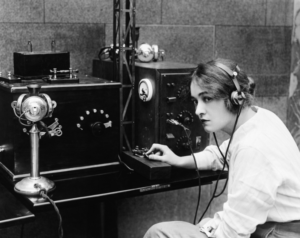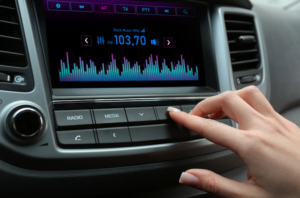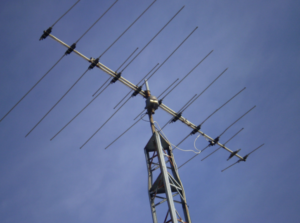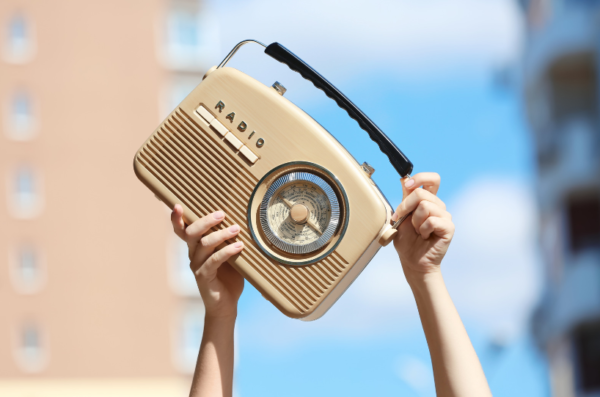Why do you have to improve the FM signal on the radio with a wire antenna? FM radio is a popular way to listen to music, news, and other content. Listening to radio music can help you improve your mental health.
However, sometimes, the quality of the FM signal could be better, resulting in static or weak sound. Fortunately, there are several ways to improve the FM signal quality, including using a wire antenna.
If you’re having trouble getting good FM radio reception, there are a few things you can do to improve the signal. One of the easiest and most effective ways is to use a wire antenna.
Wire antennas are simple to make and install, and they can significantly boost your FM radio signal.
In this article, we will discuss the basics of FM radio signals, various methods to improve FM signal quality, and how to make a wire antenna to improve your FM signal.
Read Also About How AI-powered Tools Can Improve Your Life in The Next 5 Years
Basics of FM radio signals

Before we dive in on how to improve FM signal on radio with wire antenna let’s understand what an FM signal. FM stands for frequency modulation. Unlike AM (amplitude modulation) radio signals, FM radio signals use a different method to transmit sound waves.
In FM radio, the frequency of the radio wave is modulated to carry the sound signal.
FM signals are less susceptible to interference than AM signals, which is why they are popular for music broadcasts.
However, FM signals can still be affected by various factors, such as distance, obstructions, and electronic interference.
When you take your radio outside or into an area with tall buildings, one common problem is that the signal becomes weak.
This signal loss has an explanation. Depending on the user’s needs, the radio frequencies are typically separated into distinct ranges between 400 and 470 MHz.
Radio advertisement expenditure in the Middle East and North Africa was 219 million US dollars in 2020, and it is predicted to rise to 232 million US dollars by 2024. During this time, the region’s overall advertising spending across all segments was more than $8 billion.
More Topics: Best AI Image Generators in 2023
How to make a wire antenna to boost FM radio signals
To make a wire antenna, you will need a length of insulated wire and two alligator clips. The length of the wire should be equal to one-quarter of the wavelength of the FM radio signal you want to receive. In the United States, the FM radio band ranges from 88 MHz to 108 MHz, so the wavelength of the signal ranges from 2.78 meters to 3.41 meters. This means that the ideal length for a wire antenna for FM radio reception is between 70 and 85 centimeters (about 28 to 33 inches).
Once you have cut the wire to the desired length, strip the insulation from the ends of the wire and attach the alligator clips. Then, connect one alligator clip to the antenna terminal on your radio and the other alligator clip to a metal object, such as a radiator pipe or a metal window frame.
Once your wire antenna is connected, experiment with different placements to find the spot where it gives you the best reception. You may need to try different heights and angles to find the optimal position.
More Topics: How to Leverage AI to Improve Your Article Writing
Tips for a Stronger FM Signal

There are a few things you can do to improve the FM signal on your radio, even if you’re using a simple wire antenna. Here are a few tips:
- Choose the right wire. Not all wires are created equal when it comes to FM reception. For the best results, use a single-strand copper wire that is at least 75 centimeters (2.5 feet) long.
- Place the antenna in a good location. The higher and clearer the antenna’s line of sight to the radio transmitter, the better the reception will be. Try placing the antenna near a window or on a high shelf.
- Keep the antenna away from other electronic devices. Electronic devices can interfere with FM signals, so it’s best to keep your antenna away from things like computers, TVs, and microwaves.
- Use a signal amplifier if needed. If you’re still having trouble getting a good signal, you can try using a signal amplifier. This will boost the signal strength and help you receive more stations.
The Power of Antennas: Using Wire Antennas for FM Radio Reception

improve FM signal on radio with wire antenna. Wire antennas are a simple and effective way to improve FM radio reception. They’re also very easy to make yourself. To make a basic wire antenna, simply connect a single-strand copper wire to the antenna terminals on your radio. You can then hang the wire from a window or high shelf.
If you want to improve the performance of your wire antenna, you can try making a dipole antenna. A dipole antenna is made from two wires of equal length that are connected at the center and spread apart at the ends. The ideal length for a dipole antenna is one-quarter of the wavelength of the FM radio signal. For FM radio, the wavelength is approximately 3 meters (10 feet), so a dipole antenna for FM radio would be approximately 75 centimeters (2.5 feet) long.
How to Boost Your FM Radio Reception
Here are a few additional tips for boosting your FM radio reception:
- Try different antenna locations. Move the antenna around until you find a spot where it gives you the best reception.
- Use a signal amplifier. A signal amplifier can boost the signal strength and help you receive more stations.
- Get a better antenna. If you still need help getting a good signal, you may need to upgrade to a better antenna. There are a variety of different antennas available, both indoors and outdoors.
- Switch to mono mode. If you’re listening to a station in stereo and you’re getting a lot of static, try switching to mono mode. This will reduce the amount of static and improve the sound quality.
This may interest you: How to Improve English Speaking in Daily Life
Finding the Right Spot for Your Wire Antenna
The best place for your wire antenna will depend on your specific environment. However, here are a few general tips:
- Place the antenna as high as possible. The higher the antenna, the better the line of sight to the radio transmitter and the stronger the signal will be.
- Place the antenna away from obstacles. Metal objects and other large objects can block FM signals, so it’s best to place the antenna away from these types of obstacles.
- Place the antenna away from other electronic devices. Electronic devices can interfere with FM signals, so it’s best to keep the antenna away from things like computers, TVs, and microwaves.
Improving FM Signal with a Wire Antenna

How to improve FM signal on radio with wire antenna? Here are a few additional tips for improving FM signals with a wire antenna:
- Use a balun. A balun is a device that helps to match the impedance of the antenna to the impedance of the radio receiver. This can improve the signal strength and reception quality.
- Ground the antenna. Grounding the antenna can help reduce noise and improve the signal quality. To ground the antenna, simply connect it to a metal object that is buried in the ground, such as a water pipe or ground rod.
- Use a signal amplifier (booster). A signal amplifier can boost the signal strength and help you receive more stations. However, it’s important to note that signal amplifiers can also amplify noise, so it’s important to place them correctly.
Tips to Enhance Your FM Radio Signal
In addition to the tips above, here are a few more things you can do to enhance your FM radio signal:
- Keep the antenna clean and free of corrosion. Corrosion can reduce the signal strength, so it’s important to keep the antenna clean. You can do this by wiping it down with a damp cloth regularly.
- Check the antenna connections. Make sure that the antenna connections are tight and secure. Loose connections can reduce the signal strength.
- If you’re using a dipole antenna, make sure that the two wires are the same length. A difference in length can reduce the signal strength.
- If you’re using a signal amplifier, make sure that it’s properly installed. Follow the manufacturer’s instructions carefully.
Amplifying FM Radio Signal
If you’re having trouble getting a good FM signal, you can try using a signal amplifier. A signal amplifier will boost the signal strength and help you receive more stations. However, it’s important to note that signal amplifiers can also amplify noise, so it’s important to place them correctly.
To place a signal amplifier correctly, you should first identify the source of the noise. If the noise is coming from outside, you should place the signal amplifier between the antenna and the radio receiver. If the noise is coming from inside, you should place the signal amplifier between the radio receiver and the speakers.
It’s also important to note that signal amplifiers come in different strengths. If you need help determining what signal amplifier to use, it’s best to start with a low-gain amplifier. If you’re still having trouble getting a good signal, you can try a higher-gain amplifier.
The Best Type of FM Radio Antenna
The best type of FM radio antenna depends on several factors, including your location, the strength of the signal in your area, and the type of radio you are using.
The first step in improving the FM signal on a radio with a wire antenna is to choose the best FM radio antenna.
Outdoor antennas tend to provide the best signal quality, but they can be more difficult to install. If you are using an indoor antenna, a directional antenna can help you get a better signal by focusing the antenna in a particular direction.
Examples of the best antennas on the market
When it comes to FM antennas that manage to provide the customer with quite acceptable performance, an Ancable is one of the more cost-effective and budget-friendly solutions available.
Best Features:
- Has a maximum impedance rating of 75 ohms.
- Has a cable that is 4.9 feet long.
- Includes a one-year warranty period.
Pros:
- inexpensive FM antenna for customers on a tight budget
- Standard impedance rating and a decent-length cable for convenient installation
Cons:
There might have been better build quality.
Bing sells a few FM antennas that are better suited for long-term use and are still reasonably priced, making them suitable for anyone on a limited budget.
Best Features:
- Has a maximum impedance rating of 75 ohms.
- Has a cable that is 10 feet long.
Pros:
- Value for the money radio antenna
- good wire length for simple installation
- Normal independence rating
Cons:
It is not covered by a manufacturer’s warranty that is provided.
Another good type is the TERK Amplified AM/FM Stereo Indoor Antenna and the Bingfu 75 Ohm FM Antenna.
Getting Better FM Radio Reception Today
In conclusion to our guide on improving FM signals on radio with wire antennas, By following the tips above, you can improve the FM signal on your radio and get better reception. T
Try a few different things and see what works best for you, like:
- Move your radio away from walls and other obstructions.
- Try placing your radio near a window.
- Use a signal amplifier.
- Switch your radio to mono mode.
With a little effort, you can enjoy your favorite FM radio stations without any static or interference.
FAQs
How can I boost my FM radio antenna?
One of the best ways to boost your FM radio antenna is to use a wire antenna. Wire antennas are easy to make and install, and they can significantly improve your reception.
Does speaker wire make a good FM antenna?
Yes, the speaker wire can be used as an FM antenna. However, it is important to use an insulated speaker wire. Bare speaker wire may be less effective and could also pose a safety hazard.
What is the best length of wire for an FM antenna?
The best length of wire for an FM antenna is one-quarter of the wavelength of the FM radio signal you want to receive. In the United States, the FM radio band ranges from 88 MHz to 108 MHz, so the wavelength of the signal ranges from 2.78 meters to 3.41 meters. This means that the ideal length for a wire antenna for FM radio reception is between 70 and 85 centimeters (about 28 to 33 inches).
What wire do you use for an FM antenna?
Any type of insulated wire can be used for an FM antenna. However, it is important to use a wire that is thick enough to handle the signal without losing too much power. AWG 14 or AWG 12 wire is a good choice for an FM antenna.
What is the best wire for a wire antenna?
The best wire for a wire antenna is a copper wire that is at least AWG 14 or AWG 12 gauge. Copper is a good
What is the best antenna for FM?
The best antenna for FM is a dipole antenna. A dipole antenna is a simple antenna that consists of two wires of equal length that are connected at their center. The length of the wires should be equal to one-half of the wavelength of the FM radio signal you want to receive.
How do I get good FM reception?
There are a few things you can do to get good FM reception: Use a dipole antenna. Place your radio away from walls and other obstructions. Try placing your radio near a window. Use a signal amplifier. Switch your radio to mono mode.
Does aluminum foil improve radio reception?
Aluminum foil can improve radio reception in some cases. However, it is important to note that aluminum foil is a directional antenna, so you will need to experiment with different placements and angles to find the spot where it gives you the best reception.
What boosts a radio signal?
The best way to boost a radio signal is to use an antenna. Antennas are designed to amplify radio signals. You can also use a signal amplifier to boost your radio signal. Signal amplifiers are electronic devices that can increase the strength of a radio signal.

